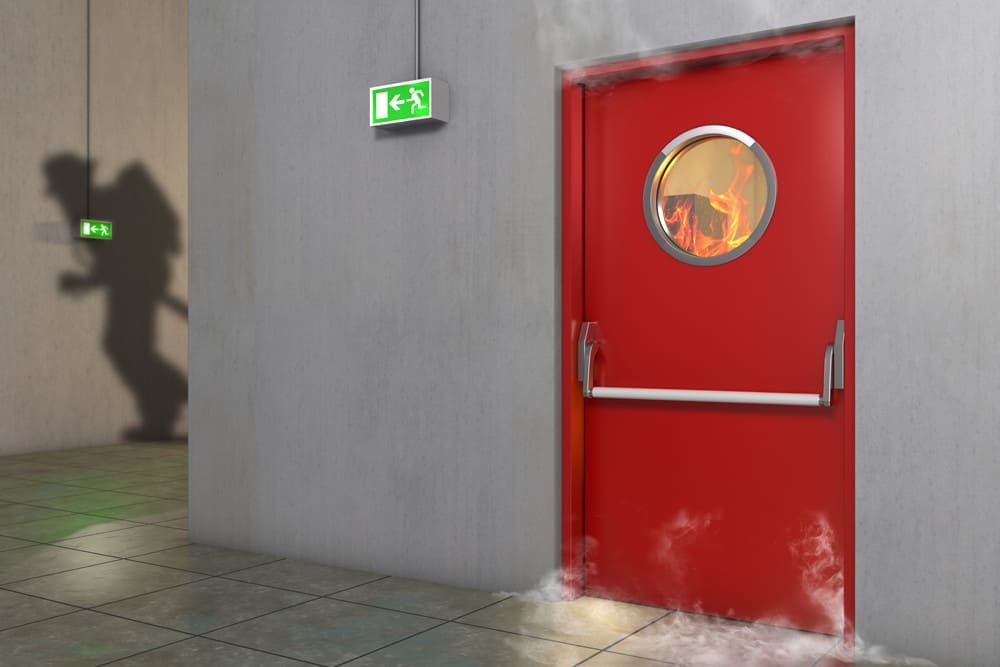
Most of us, don’t think twice about fire doors until a fire actually occurs in a building. In which case, they play an essential role in saving lives and protecting property. When they fail, the consequences can be devastating. In fact, inadequate performance was a contributing factor in the Grenfell Tower tragedy.
If you are a ‘responsible person’ for a building, you have a legal duty to ensure your fire doors are in place and able to function as they’re meant to. But what is a fire door, how do they work and how do you go about ensuring they’re in suitable condition? In this article, we take a closer look at the legal requirements and explain what you need to know.
Fire Doors Explained
Technically known as a fire resisting door, it’s an essential part of fire safety equipment. It can be a door or a shutter.
They’re designed to stay open for people and closed for fire and smoke. This is their purpose. They contain the heat, flames and smoke in one part of a building, while providing clear and safe evacuation paths to another part, for anyone trapped inside.
Fire doors are part of the fire safety design of a building. They are classified as passive fire protection measures, meaning that they require no action for them to operate during a fire.
Fire Door Materials
Fire doors can be made of a variety of materials, such as:
- Timber
- Gypsum
- Metal (such as aluminium or steel)
- Glass
- Composite or a combination of materials
Wooden or metal doors are the most common.
If it contains glass or glazing, the glass must be fire rated and able to act as a barrier against smoke and flames. Fire-rated glass can withstand temperatures over 900°C while normal glass can withstand up to 120°C.
Wooden doors are made with a solid core that has been covered by an outer shell. A variety of materials such as magboard, particleboard, timber and MDF are used. If a wooden fire door is painted, the paint must be classified as fire-retardant.
Metal doors provide a higher level of protection against fire when compared to wood or glass fire doors. Metal doors are commonly found in healthcare facilities or public buildings.
Testing and Rating
Whatever the design, the doors must have fire test evidence. This evidence must be to British or European standards, and can be:
- A single fire test report, or several
- An assessment issued by an organisation accredited by UKAS
- A certification provided by a third party
Tests provide a rating of performance, based on how long it will withstand a fire. If a door is able to function for 30 minutes under fire test conditions, it’s said to have 30 minutes of “integrity” and rated FD30, or E30, in the European rating system.
Other ratings you may find on doors, include:
- FD60 – 60 minutes of fire resistance
- FD120 – 120 minutes of fire resistance
- FD240 – 240 minutes of fire resistance
The most commonly found grades are FD30 and FD60. These doors are generally found in office buildings, residential buildings and single-storey business premises. They’re designed for buildings that don’t have complicated layouts, aren’t overly large and can be evacuated quickly. Larger buildings will require FD120 or FD240 doors.
Smoke Resistance
Not all fire doors are smoke resistant. But certain doors must be both fire and smoke rated. Smoke inhalation kills more people in fires than fire. So, the correct functioning of these doors is vital.
A smoke resistant door is signified with an “S” at the end. So, a 60 minute fire resistant smoke rated door is then labelled an“FD60S”.
You will most often find these types of doors leading into places like hallways. Hallways are a central means of escape in a fire, so cannot be allowed to fill with smoke.
Features of Fire Doors
Each unique design is specific to meet the needs of the building and its location. Features to be aware of, include:
- Label – Labels can be found on the top or edge, which indicate the manufacturer, rating and certification
- Seals – Fire and smoke can leak around the edges of doors, so many doors are equipped with seals designed to prevent this
- Hinges – Wooden doors must have at least three hinges, while metal doors must have at least four and they must be commercial-grade hinges that are heat-resistant
- Closer – They must be equipped with an automatic door closer that operates via a hydraulic or spring-loaded mechanism
- Signs – Appropriate signage must be visible on the door, such as ‘fire exit’, or ‘fire door – keep shut.’ These signs are usually blue with white lettering.
Any components must be specifically rated for that door. If they aren’t, the door won’t perform as expected in a fire. For instance, if you swapped a hinge out with a non-tested, rated hinge, it could have disastrous consequences.

Do You Have to Install Fire Doors in Your Business?
Business owners and building owners are required by law to have fire doors installed throughout their properties. For business premises and mixed-use buildings, the requirement is mandated by the Regulatory Reform (Fire Safety Order) 2005.
Domestic dwellings over three storeys, blocks of flats and houses in multiple occupation (HMO) are governed by the Fire Safety (England) Regulations 2022.
Under these regulations, business owners and property owners are designated as being responsible for ensuring that an appropriate number of them are installed and that they are regularly inspected, checked, and maintained to ensure they’re in working order.
How Often Should Fire Doors Be Checked?
In non-domestic business properties or mixed-use properties, it’s recommended that fire doors should be professionally inspected once every six months. They should be given a cursory examination as part of your daily fire safety procedures. Regular, more involved checks should be conducted on a quarterly basis. If the fire doors in the building are in constant use, then a weekly check is advised.
The Fire Safety (England) Regulations 2022 now mandate that checks be conducted once every three months in buildings over five storeys or with two or more domestic dwellings.
To learn more about how to do simple fire door checks yourself, visit our article on the subject.
Learn to Conduct Fire Door Inspections Yourself
Many business owners and building owners prefer to use a professional assessor for more involved inspections. However, with the right training, you or an employee can conduct these inspections for the regular checks.
Our Fire Door Inspection Training course will teach you how to properly assess your doors to ensure they are in good working order. These skills will help you to protect your property and staff and make sure you are compliant with health and safety legislation.
Our training consists of three modules with a total running time of approximately three hours. The modules can be broken up into smaller segments so you can work your way through them at your convenience.




























































































































































































































































































































































































































































































































































































































































































































































